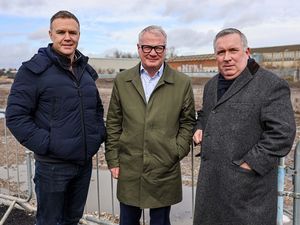Legacy of construction giant Carillion's chaotic collapse still festers five years on
Five years on from the chaotic collapse of Carillion and the aftershocks are still being felt.
The outsourcing giant went into liquidation with debts of £7 billion at a cost of 3,000 jobs – including 400 in Wolverhampton where the firm’s main headquarters was based.
Thousands more would go across the supply chain, while Carillion’s demise also saw more than 400 major public sector projects including hospitals, schools and prisons immediately plunged into crisis.
Some, such as the Midland Met hospital in Smethwick, are yet to be completed to this day in the face of sky-rocketing budgets and seemingly endless delays.
But despite several damning investigations into the doomed contractor and many millions of pounds in fines being handed out by financial regulators, the wrangles around the UK’s biggest corporate failure in decades continue.
Last year the Official Receiver filed a £1.3bn claim on behalf of creditors, which alleges KPMG failed in its duties as auditor of Carillion.
The claims include that KPMG failed to properly audit the accounting of 20 significant construction contracts, while it is alleged that the value of two contracts alone was misstated by £351.9m.
For its part, KPMG has denied its auditors were at fault, insisting that the claim is “without merit” and vowing to “robustly defend the case”.
In a statement issued in November, the firm said: “Responsibility for the failure of Carillion lies solely with the company’s board and management, who set the strategy and ran the business.”
The blame game has become almost synonymous with the fallout of the Carillion saga, which has cost the taxpayer more than £150m.
Dozens of fines have been handed out.
KPMG was fined £14.4m following a probe by the Financial Reporting Council, which concluded that former staff forged documents and misled the FRC over audits for companies including Carillion.
KPMG fully cooperated with the investigation and admitted guilt, with its chief executive saying after a tribunal hearing that the accounting giant was “deeply sorry that such serious misconduct occurred in our firm".
“It was unjustifiable and wrong. It was a violation of our processes and a betrayal of our values.”
Meanwhile former chief executive Richard Howson, a member of the board from 2009 until he stepped down in July 2017, and two other former directors were fined £870,200 for “recklessly” publishing misleading accounts.
The three have appealed the level of fines. The Financial Conduct Authority (FCA) said that three of Carillion’s financial statements – published between December 2016 and May 2017 – were “misleading and did not accurately or fully disclose the true financial performance of Carillion”.
In total it published four lengthy reports, detailing the failings at Carillion in the build-up to its collapse.
It accuses directors of keeping crucial information from their audit committee and board, and of changing financial policies to paint a more positive picture of an increasingly desperate state of affairs. In hindsight, it is not hard to see where it all went wrong.
Carillion relied on mega-contracts to build some of the UK’s most important infrastructure projects, such as NHS hospitals, major road schemes and HS2. But many of them proved to be far less lucrative than bosses expected. On paper the firm had revenues of more than £5bn, but by mid-2017 – the summer before its collapse – the cracks had started to appear.
Shares in Carillion plummeted by 70 per cent in a month as it was forced to announce a profit warning following an £845m writedown, of which £375m related to public-private partnerships (PPPs) such as the aforementioned Midland Met and Royal Liverpool University hospital. As its contracts continued to underperform, Carillion’s debts soared to £900m. But when the firm needed an urgent £300m cash injection, the banks that lent it money refused to put more in and the Government refused to bail it out.
With Carillion unable to continue trading, liquidation became the only option.
The 700-bed Midland Met was one of four contracts that would prove to be the straw that broke the camel's back. The project was expected to take less than three years to complete when work started in January 2016 with a budget of £350m. But it was immediately beset by delays and work stopped altogether when Carillion went under. It is now scheduled to open next Spring, with budget estimates now close to the £1bn mark.
The failure of the scheme, along with the wider collapse of Carillion, raised questions about the Government’s reliance on PPP for major contracts.
In theory, it enabled companies to land lucrative contracts while the Government would get new infrastructure more quickly and at a good price, as private companies would bid for the work and the market would ensure best value for taxpayers. The reality was that as competition mounted, firms would land contracts with increasingly tiny profit margins. This meant that when problems arose – which they invariably did – profit would be wiped out and in many cases, significant losses occurred. So five years after the demise of Carillion, have lessons been learned?
Not according to Labour MP John Spellar, who has kept a close eye on the troubles surrounding the Midland Met since the project’s inception.
“If we are considering whether things have improved since Carillion, then I would have to say ‘not much’,” the Warley MP said.
“We still have huge services companies with big contracts who don’t actually know what they are doing. Sadly the Government has become largely dependant on outsourcing and so we have to put up with worse service for more cost.
“I think the contract for the Midland Met is better, but I still don’t think the civil service understands procurement.
“The focus is still on cheapness and in many cases they are not taking account of past performance. They are also not building for the future by insisting on training ratios on contracts, to ensure we have apprentices trained up for future contracts.”





